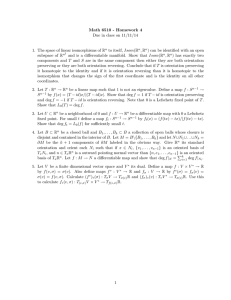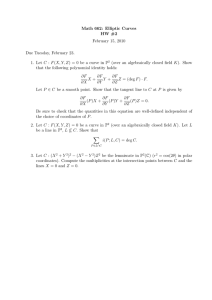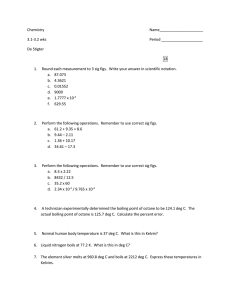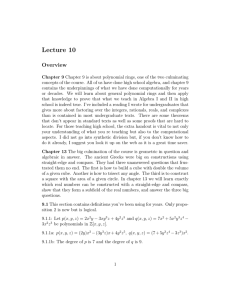Document 13570060
advertisement
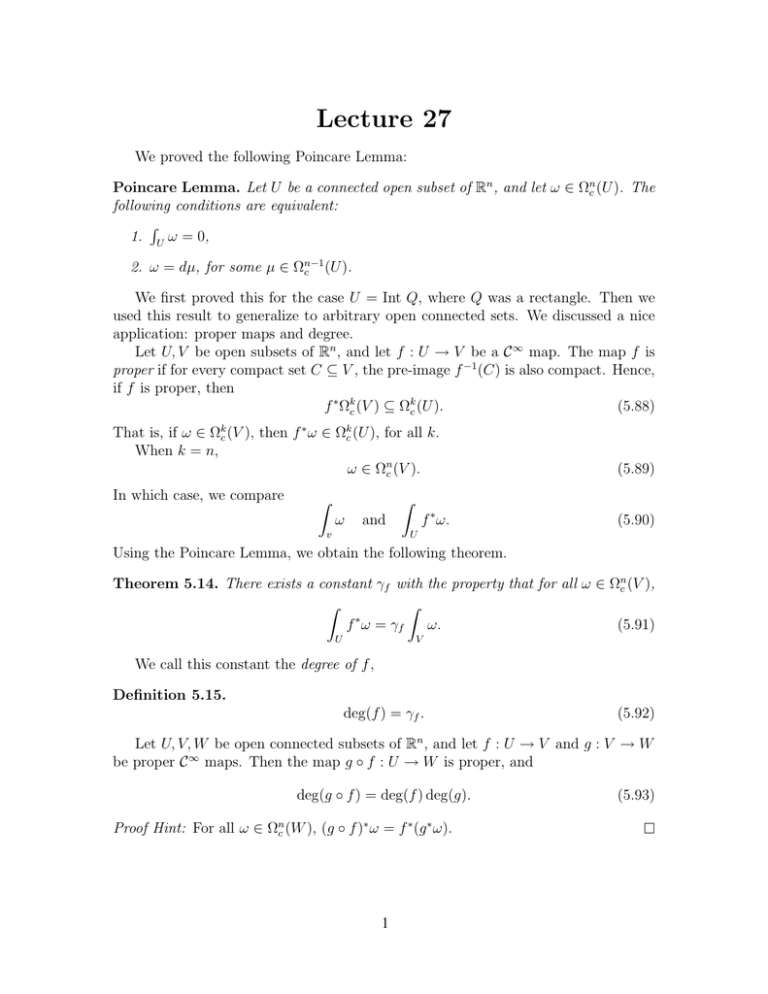
Lecture 27
We proved the following Poincare Lemma:
Poincare Lemma. Let U be a connected open subset of Rn , and let ω ∈ Ωnc (U ). The
following conditions are equivalent:
�
1. U ω = 0,
2. ω = dµ, for some µ ∈ Ωn−1
(U ).
c
We first proved this for the case U = Int Q, where Q was a rectangle. Then we
used this result to generalize to arbitrary open connected sets. We discussed a nice
application: proper maps and degree.
Let U, V be open subsets of Rn , and let f : U → V be a C ∞ map. The map f is
proper if for every compact set C ⊆ V , the pre­image f −1 (C) is also compact. Hence,
if f is proper, then
f ∗ Ωkc (V ) ⊆ Ωkc (U ).
(5.88)
That is, if ω ∈ Ωkc (V ), then f ∗ ω ∈ Ωkc (U ), for all k.
When k = n,
ω ∈ Ωnc (V ).
(5.89)
In which case, we compare
�
�
ω
f ∗ ω.
and
v
(5.90)
U
Using the Poincare Lemma, we obtain the following theorem.
Theorem 5.14. There exists a constant γf with the property that for all ω ∈ Ωnc (V ),
�
�
∗
f ω = γf
ω.
(5.91)
U
V
We call this constant the degree of f ,
Definition 5.15.
deg(f ) = γf .
(5.92)
Let U, V, W be open connected subsets of Rn , and let f : U → V and g : V → W
be proper C ∞ maps. Then the map g ◦ f : U → W is proper, and
deg(g ◦ f ) = deg(f ) deg(g).
Proof Hint: For all ω ∈ Ωnc (W ), (g ◦ f )∗ ω = f ∗ (g ∗ ω).
1
(5.93)
We give some examples of the degree of various maps. Let f = Ta , the transpo­
sition by a. That is, let f (x) = x + a. From #4 in section 4 of the Supplementary
Notes, the map Ta : Rn → Rn is proper. One can show that deg(Ta ) = 1.
As another example, let f = A : Rn → Rn be a bijective liner map. Then
�
1
if det A > 0,
deg A =
(5.94)
−1 if det A < o.
We now study the degree as it pertains to orientation preserving and orientation
reversing maps.
Let U, V be connected open sets in Rn , and let f : U → V be a diffeomorphism.
Take p ∈ U . Then Df (p) : Rn → Rn is one­to­one and onto. The map f is orientation
preserving if det Df (p) > 0 for all p ∈ U , and the map f is orientation reversing if
deg Df (p) < 0 for all p ∈ U .
Theorem 5.16. If f is orientation preserving, then deg(f ) = 1; if f is orientation
reversing, then deg(f ) = −1.
Proof. Let a ∈ U and b = f (a). Define
fold = f,
(5.95)
fnew = T−b ◦ fold ◦ Ta ,
(5.96)
and define
where T−b : Rn → Rn and Ta : Rn → Rn are transpositions by −b and a, respectively.
By the formula deg(g ◦ f ) = deg(f ) deg(g),
deg(fnew ) = deg(T−b ) deg(fold ) deg(Ta )
= deg(old ).
(5.97)
By replacing f with fnew , we can assume that 0 ∈ U and f (0) = 0.
We can make yet another simplification, that Df (0) = I, the identity. To see this,
let Df (0) = A, where A : Rn → Rn . Taking our new f , we redefine fold = f , and we
redefine fnew = A−1 ◦ fold . Then,
deg(fnew ) = deg(A) deg deg(fold ),
(5.98)
deg A = deg(Dfold )
�
1
if Dfold is orient. preserving,
=
−1 if Dfold is orient. reversing.
(5.99)
where
2
We again replace f with fnew . It suffices to prove the theorem for this new f . To
summarize, we can assume that
0 ∈ U,
f (0) = 0.
and Df (0) = I.
(5.100)
Consider g(x) = x − f (x) (so f (x) = x − g(x)). Note that (Dg)(0) = I − I = 0. If
we write g = (g1 , . . . , gn ), then
�
�
∂gi
(0) = 0.
(5.101)
∂xj
So, each
∂gi
(0)
∂xj
= 0.
Lemma 5.17. There exists δ > 0 such that for all |x| < δ,
|g(x)| ≤
|x|
.
2
(5.102)
∂gi
Proof. So far, we know that g(0) = 0 − f (0) = 0, and ∂x
(0) = 0. By continuity,
j
there exists δ > 0 such that
�
�
� ∂gi
�
1
�
�
(5.103)
�
∂xj (x)
�
≤ 2n ,
for all |x| < δ. Using the Mean­value Theorem, for all |x| < δ,
gi (x) =gi (x) − gi (0)
� ∂gi
=
(c)xj ,
∂xj
(5.104)
where c = t0 x for some 0 < t0 < 1. So,
n
�
1
|gi (x)| ≤
|xi |
2n
i=1
1
max{|xi |}
2
1
= |x|.
2
≤
Define f˜ : Rn → Rn as follows. Let ρ ∈
properties
⎧
⎪
⎨1
ρ(x) =
0
⎪
⎩
0 ≤ ρ(x) ≤ 1
C0∞ (Rn ), defined to have the follow
if |x| < δ/2,
if
|x| > δ,
otherwise.
Remember that f (x) =
x − g(x). Define
�
x − ρ(x)g(x) if |x| < δ,
f˜ =
x
if |x| > δ.
3
(5.105)
(5.106)
(5.107)
Claim. The map f˜ has the following properties:
1. f˜ = f (x) for all |x| < 2δ ,
2. f˜ = x for all |x| > δ,
3. |f˜(x)| ≥
|x|
,
2
4. |f˜(x)| ≤ 2|x|.
Proof. We only proof properties (3) and (4). First we prove property (3). We have
f˜(x) = x − ρ(x)g(x) = x when |x| ≥ δ, so |f˜(x)| = |x| when |x| ≥ δ . For |x| < δ, we
have
|f˜(x)| ≥ |x| − ρ(x)|g(x)|
= |x| − |g(x)|
|x|
≥ |x| −
2
|x|
.
=
2
(5.108)
We now prove property (4). We have f˜(x) = x − ρ(x)g(x), so |f˜(x)| = |x| for
x ≥ δ. For x < δ, we have
|f˜(x)| ≤ |x| + ρ(x)|g(x)|
1
≤ |x| + |x|
2
≤ 2|x|.
(5.109)
Let Qr ≡ {x ∈ Rn : |x| ≤ r}. The student should check that
Property (3) =⇒ f˜−1 (Qr ) ⊆ Q2r
(5.110)
and that
Property (4) =⇒ f˜−1 (Rn − Q2r ) ⊆ Rn − Qr
(5.111)
Notice that f˜−1 (Qr ) ⊆ Q2r =⇒ f˜ is proper.
Now we turn back to the map f . Remember that f : U → V is a diffeomorphism
and that f (0) = 0. So, the set f (Int Qδ/2 ) is an open neighborhood of 0 in Rn . Take
ω ∈ Ωnc (f (Int Qδ/2 ) ∩ Int Qδ/4 )
such that
(5.112)
�
ω = 1.
Rn
4
(5.113)
Then,
f ∗ ω ∈ Ωnc (Qδ/2 )
(5.114)
f˜∗ ω ∈ Ωnc (Qδ/2 ),
(5.115)
and
by Equation 5.110. This shows that f ∗ ω = f˜∗ ω. Hence,
�
�
�
∗
∗
f ω=
f˜ ω = deg(f )
ω
U
U
V
�
˜
= deg(f )
ω,
(5.116)
V
where
�
ω = 1.
(5.117)
V
Therefore,
deg(f ) = deg(f˜).
(5.118)
Now, let us use Equation 5.111. Choose ω ∈ Ωnc (Rn − Q2δ ). So,
f ∗ ω ∈ Ωnc (Rn − Qδ ).
(5.119)
Again we take
�
ω = 1.
(5.120)
f˜∗ ω = ω.
(5.121)
Rn
By property (2), f˜ = I on Rn − Qδ , so
Integrating,
�
n
˜∗
f ω = deg(f˜)
R
�
n
�
n
ω=
R
ω.
(5.122)
R
Therefore,
deg(f ) = deg(f˜) = 1.
5
(5.123)

